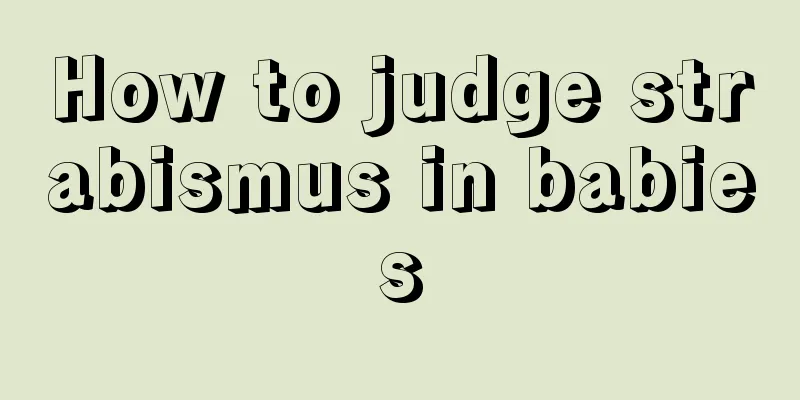How to judge strabismus in babies

|
Infant strabismus is a relatively common disease at present. First of all, it needs to be examined and diagnosed. The first step is to face the problem of strabismus correctly. When it is determined that the child really has strabismus, standardized correction can be given so that recovery can be faster. In addition, it is necessary to find appropriate and effective methods for treatment to avoid aggravating some physical conditions or diseases and causing trouble and burden to the body. Inspection and judgment 1. Covering method The patch method is a way to check whether the extraocular muscles function normally or balanced. It can only be qualitative, not quantitative. Generally, it is possible to detect heterotropia or strabismus of more than 5 degrees. The inspection methods include alternating eye cover and monocular cover. First, perform the alternate eye cover method. If eye misalignment is detected, then perform the single eye cover method. 1. Alternating eye cover method: Let the subject face the light and focus both eyes on a distant (five meters away) or near (33 cm) target. First observe whether the position of both eyes is balanced, and then use an opaque blindfold or your palm to repeatedly and alternately block the vision of the left and right eyes. The subject is prevented from looking with both eyes at the same time, and the eye that is no longer covered is observed to see if there is any movement at the moment of alternating covers. judge For those who are in the correct position: when you cover his other eye, the uncovered eye does not move, and the covered eye does not show any deviation. Strabismus: When covering another eye, the uncovered eye immediately turns from the deflected position to the direction of the target being looked at in front of it, while the covered eye remains deflected. 2. Monocular cover method: The subject looks at a distant (five meters) or near (33 cm) target with both eyes, and repeatedly covers and removes one eye with an eye patch or hand (the other eye is never covered), and observes whether the two eyes move, and then examines the other eye with the same method. judge Heterophoria: When the eye is not covered, it always fixes the target without moving, but when the other eye is covered, it deviates. When the eye is uncovered, it can turn to look at the target. If it turns inward, it is called exotropia; if it turns outward, it is called esotropia; if it turns downward, it is called hypertropia. Co-rotational strabismus: (1) Monocular strabismus: Assume that the right eye has monocular strabismus. When the right eye is covered and the left eye is focused on the target, the right eye deviates. When the right eye cover is removed, both eyes remain in the original position. On the contrary, when you cover the left eye (the normal eye) and let the right eye look at the target, the left eye will deviate; but when you remove the cover on the left eye, the left eye will immediately return to its original gaze position, while the right eye will deviate in the direction of strabismus, and both eyes will appear to be rotating. (2) Alternating strabismus: Cover the right eye and ask the left eye to look at the target, or cover the left eye and ask the right eye to look at the target. When the cover is removed, both eyes remain in place and do not move. 2. Maddox rod inspection method Mainly used to check latent strabismus. The Maddock rod (abbreviated as Maddock rod) is composed of multiple small glass rods arranged parallel to each other. Since the cylindrical lens has the property of not refracting the light parallel to its axis and refracting the light perpendicular to the axis, the light source (point-shaped) viewed through the Maddock rod becomes a light strip perpendicular to the axis of the cylindrical lens. The examination is conducted in a dark room, and the examinee is asked to look at a light 5 meters away. 1. When checking the horizontal eye position, wear a horizontally placed Maddox rod in front of one eye. If the subject sees a vertical light bar passing through the light, there is no horizontal strabismus; if the vertical light bar is biased to one side of the light, there is horizontal latent strabismus. When the vertical light bar is on the same side of the eye wearing the Maddox rod (the right eye wears the Maddox rod, and the light bar is on the right side of the light), it is esotropia; when the vertical light bar is on the opposite side (the right eye wears the Maddox rod, and the light bar is on the left side of the light), it is exotropia. 2. When checking the vertical eye position, wear a vertically placed Maddox rod in front of the right eye. If the subject sees a horizontal light bar passing through the light point, there is no vertical strabismus. If the horizontal light bar is biased above or below the light, there is vertical heterotropia. If the light bar is at the bottom, it means the right eye is strabismus; if the light bar is at the top, it means the left eye is strabismus. |
<<: How long does it take for baby's pillow baldness to heal?
>>: Baby has a lump behind the ear that moves
Recommend
Baby's palms and soles are hot
Baby doctor will cause hot palms and feet, and ev...
What should I do if my 2-year-old has a persistent high fever?
Many children will feel uncomfortable during the ...
Congenital laryngeal stridor in newborns
When a baby is born, every parent hopes that the ...
Why do children have a lot of dandruff?
In the eyes of many people, dandruff seems to exi...
What are the benefits of learning Taekwondo for children
Many families send their children to school to pr...
What is going on when a child has a seizure?
The physical health of children is very important...
Infant suction device plus nursing treatment
After catching a cold, many babies still have dif...
What to do if your baby has allergies and rashes
We all know that babies are in a period of rapid ...
What to do if your child has tonsillitis? Seven ways to help you
Tonsillitis is one of the most common diseases in...
What to do if your one-year-old baby has protruding ribs
Some babies will have some symptoms when they are...
What to do if your child has hunchback?
Hunchback has become a disease common among the e...
How to educate a three-year-old girl?
Three years old is an important period for a baby...
What should I do if my child has an itchy throat?
Although many parents attach great importance to ...
What to do if your baby has diarrhea at three and a half months old
Babies who are just three and a half months old a...
What causes birthmarks in babies? Maybe it's genetic
There are many reasons for the formation of birth...









